|
| December 2007 |
Employer-Based Health Insurance |
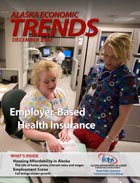 |
The Alaska departments of Health and Social Services, Labor and Workforce Development, and Commerce, Community and Economic Development developed a survey that was distributed to a sample of Alaska’s private-sector and local government employers by the Department of Labor during the summer of 2006. The survey focused on peak seasonal employment in an attempt to assess the impact of fi rm size, cost and other issues related to employer offering and employee take-up of health insurance at the high point of Alaska’s 2006 employment.
December 2007 Trends
|
| |
|
| November 2007 |
Alaska’s Fishermen - They don’t just fish for a living |
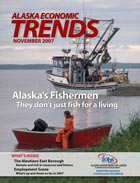 |
Many people hold more than one job during the year. Given the often seasonal nature of the work and recent fluctuations in resource prices, it’s not surprising that Alaska’s fishermen are no different than other workers.
November 2007 Trends |
| |
|
| October 2007 |
Population Projections, 2007 to 2030 |
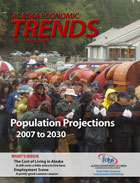 |
What will Alaska’s population look like in 2030? Projections by the Alaska Department of Labor and Workforce Development indicate that the state’s total population will most likely increase by 25 percent, from 670,053 in 2006, to 838,676 in 2030. The population age 65 and older is projected to experience the largest growth of any age group, with a near tripling in size as Alaska’s baby boomers move into their retirement years. Growth is also expected to be substantial for Alaska’s Native population, which is projected to increase by nearly 45,000 people by 2030.
October 2007 Trends |
| |
|
| September 2007 |
Alaska's Non-Oil Tax Revenue |
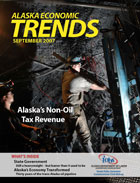 |
Alaska’s tax revenue grew at an average annual rate of 12 percent from fiscal year 2001 through fiscal year 2006. (See Exhibit 1.) This growth came from both oil taxes and non-oil taxes. From 2006 to 2011, however, oil tax revenue is projected to decline at an average rate of 2 percent a year, while non-oil tax revenue is projected to increase at an average rate of 4 percent.
September 2007 Trends |
| |
|
| July / August 2007 |
The Trends 100 |
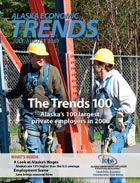 |
The Providence Health System first grabbed the top spot as Alaska’s largest private employer in 2001, when its employment was 3,369. A decade ago it was 2,261. Now, with its 2006 work force of 3,991, Providence will soon become the fi rst private-sector employer with an average monthly work force for the year exceeding the 4,000 mark.
July / August 2007 Trends |
| |
|
| June 2007 |
The Matanuska-Susitna Borough |
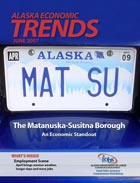 |
By most economic measures, the Matanuska-Susitna Borough has been a clear standout in Alaska over the last two decades. The source of the borough’s growth is no mystery: it’s within commuting distance to Anchorage, the state’s largest city, and it has more affordable housing and more room to grow than Anchorage. Such a pattern of development – faster growth in the area surrounding a major city than in the city itself – is unique in Alaska, but not unlike many other parts of the country.
June 2007 Trends |
| |
|
| May 2007 |
Professional and Business Services |
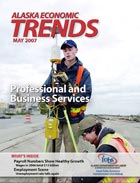 |
What do law offices, advertising agencies, telemarketing businesses, bank holding companies, armored car services and landfills have in common? Although it’s tempting to say not much – or to think it’s the first line of a joke – the correct answer is that they’re all lumped together in a group called professional and business services, one of 11 major categories under which payroll jobs are published in Alaska Economic Trends.
May 2007 Trends |
| |
|
| April 2007 |
A Supply of Alaska Workers for the Gas Line |
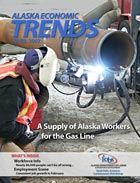 |
Thirty years ago two welders finished the final weld on the trans-Alaska oil pipeline, a 20th century engineering marvel that has pumped billions of barrels of oil to market and billions of dollars into Alaska’s economy. Next month’s anniversary comes in the midst of negotiations and planning for another pipeline – the gas line to ship natural gas from the North Slope, at least partly along the same route as the oil pipeline.
April 2007 Trends |
| |
|
| March 2007 |
American Community Survey |
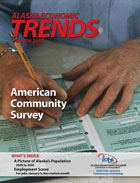 |
The American Community Survey is a new national survey conducted every month by the U.S. Census Bureau designed to provide state and local data more frequently than every 10 years. (See sidebar, below.) When the Census Bureau released the 2005 ACS data in the fall of 2006, it marked the survey’s national debut as the new replacement for the long form sample data collected during decennial censuses.
March 2007 Trends
|
| |
|
| February 2007 |
Alaska's Unemployment Insurance Benefits |
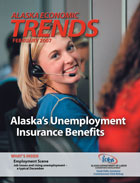 |
One of the primary duties of the Alaska Department of Labor and Workforce Development is to pay unemployment insurance benefits to unemployed workers. The department continually evaluates the health of Alaska’s unemployment insurance system and identifies areas where it can be improved.
February 2007 Trends |
| |
|
| January 2007 |
Employment Forecast for 2007 and 2008 |
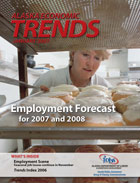 |
For the 19th consecutive year, Alaska added jobs to its economy in 2006. The year-to-year growth has generally been moderate, but 19 years without a downturn is an impressive streak, especially given the two national recessions that occurred over that period, declining oil production from the North Slope and oil prices throughout much of the 90s below $15 a barrel.
January 2007 Trends |














